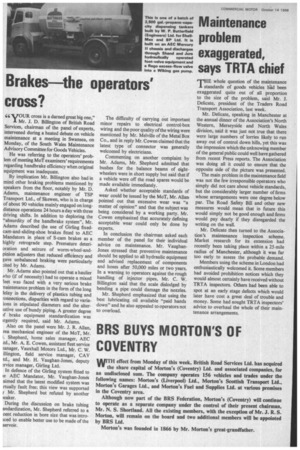Brakes the operators' cross?
Page 40

If you've noticed an error in this article please click here to report it so we can fix it.
VOUR cross is a darned great big one," 1. Mr. J. D. Billington of British Road Services, chairman of the panel of experts, intervened during a heated debate on vehicle maintenance at a meeting in Swansea, on Monday, of the South Wales Maintenance Advisory Committee for Goods Vehicles. He was referring to the operators' problem of meeting MoT examiners' requirements regarding handbrake efficiency when original equipment was inadequate.
By implication Mr. Billington also had in mind other braking problems mentioned by speakers from the floor, notably by Mr. D. Adams, maintenance engineer of TSP Transport Ltd., of Skewen, who is in charge of about 90 vehicles mainly engaged on longdistance operations 24 hours a day with three driving shifts. In addition to deploring the "absurdity of the handbrake system", Mr. Adams described the use of Girling fixedcam-and-sliding-shoe brakes fitted to AEC Mandators in place of S-cam brakes as a highly retrograde step. Premature deterioration and seizure of worm-wheel-andpinion adjusters that reduced efficiency and gave unbalanced braking were particularly ..ited by Mr. Adams.
Mr. Adams also pointed out that a haulier
Nho (if of necessity) had to operate a mixed
leet was faced with a very serious brake naintenance problem in the form of the long lelay in the delivery of plastics tubing and onnections, disparities with regard to variaions in stipulated diameters and the alterlative use of bundy piping. A greater degree >f brake equipment standardization was irgently required, said Mr. Adams. Also on the panel were Mr. J. R. Allan, rea mechanical engineer of the MoT, Mr. ;. Shepherd, home sales manager, AEC td.. Mr. A. E. Cowen, assistant fleet service imager, Vauxhall Motors Ltd., Mr. C. W. illington, field service manager, CAV td., and Mr. H. Vaughan-Jones, deputy rvice manager, Girling Ltd.
In defence of the Girling system fitted to le AEC Mandator, Mr. Vaughan-Jones aimed that the latest modified system was rtually fault free; this view was supported y Mr. Shepherd but refuted by another waken During the discussion on brake tubing andardization, Mr. Shepherd referred to a cent reduction in bore size that was introiced to enable better use to be made of the servoir. The difficulty of carrying out important minor repairs to electrical control-box wiring and the poor quality of the wiring were mentioned by Mr. Melville of the Metal Box Co., and in reply Mr. Cowen claimed that the latest type of connector . was generally welcomed by electricians.
Commenting on another complaint by Mr. Adams, Mr. Shepherd admitted that bushes for the balance beams of eightwheelers were in short supply but said that if a vehicle were off the road spares would be made available immediately.
Asked whether acceptable standards of wear could be issued by the MoT, Mr. Allanpointed out that excessive wear was "a matter of opinion" and that the subject was being considered by a working party. Mr. Cowen emphasized that accurately defining acceptable wear could only be done by experts.
In conclusion the chairman asked each member of the panel. for their individual advice on maintenance. Mr. VaughanJones stressed that preventive maintenance should be applied to all hydraulic equipment and advised replacement of components and hoses after 50,000 miles or two years. In a warning to operators against the rough handling of injector pipes, Mr. C. W. Billington said that the scale dislodged by bending a pipe could damage the nozzles.
Mr. Shepherd emphasized that using the best lubricating oil available "paid hands down" and he also appealed to operators not to overload.
































































































































